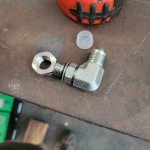Fuel vent solution... I had originally crafted a 3 port fuel return to the tank. It had tubes that extended down into the bottom of the tank to help reduce aeration. When the fuel system finally went together I was able to just use the one return from the FASS and then combined the 3 engine returns (CP3, FPRV, and Head Drain) into one system using some check valves. This left me with an unused port so I pulled the return head, removed the extra dipper tube and am using it for some sort of air return.
SS weld bungs are expensive, especially when you add in shipping, so I grabbed a 9/16"-18 SS nut, machined an O-ring seat in one side and then shouldered it down to create a slug. Using an ORB to JIC 90, some Brass fittings, and JIC flares on copper tubing to give it an aesthetic. Once the brass and copper gets some tarnish on it, it should look good. Pushlock hose to finish the connection for sake of things moving around some.
I started to do a sweeping bend to match the radius of the filler neck but it wasn't coming out smooth. If I end up hating it I can redo it.
I also got some work in on the floors and this is posted elsewhere too from me asking for thoughts on methods. I ended up grabbing a router bit with a bearing guide on it. Chucked it into the 1943 Bridgeport that was originally owned by the Navy in WW2, so appropriately... and then set the milling clamps with some tube spacers to act as guides and just hand fed the boards through... ie, Bridgeport router table.
The aluminum strips are then located, first hole drilled and spare drill bit inserted to the hold the strip from moving any and the remainder of the holes are drilled, strip removed and tapped for 10-32, and then the whole thing installed again with SS countersunk screws from the bottom of the plywood form board. The idea is that this is one big entity that can get installed or removed without having to take apart all of the boards. I ran out of screws because my vendor sent me one bag of 10-32s and another bag of weird sheetmetal screws that I didn't order instead of what I needed a few more of. So waiting on hardware. - McMaster rarely messes up too.

